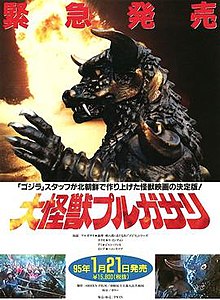
Back بولغاساري Arabic پولجاسارى ARZ Pulgasari German Pulgasari Greek Pulgasari Spanish Pulgasari Basque Pulgasari Finnish Pulgasari French Pulgaszari Hungarian Pulgasari ID
| Pulgasari | |
|---|---|
 Japanese VHS flyer | |
| Directed by |
|
| Written by |
|
| Produced by |
|
| Starring |
|
| Cinematography |
|
| Edited by | Kim Ryŏnsun |
| Music by | Sŏ Chŏnggŏn |
Production companies |
|
| Distributed by | Twin (1995) Raging Thunder (1998) |
Release dates |
|
Running time | 95 minutes |
| Countries |
|
| Language | Korean |
| Budget | ¥200–300 million ($2–3 million) |
Pulgasari[a] is an epic monster film[i] directed and produced by Shin Sang-ok in 1985 during his North Korean abduction. A co-production between North Korea, Japan, and China, it is considered a remake of Bulgasari, a 1962 South Korean film that also depicts Bulgasari/Pulgasari, a creature from Korean folklore. The ensemble cast includes Chang Sŏnhŭi, Ham Kisŏp, Ri Chongguk, Ri Ingwŏn, and Yu Kyŏngae, with Kenpachiro Satsuma in the title role. Set during the Goryeo dynasty, Pulgasari follows a blacksmith's daughter who brings to life a metal-eating monster her late father created to defeat the monarchy.
Shin and his wife, Choi Eun-hee, were kidnapped in 1978 by agents of Kim Jong Il, and held captive in North Korea. Pulgasari was put forward in February 1985 to capitalize on the success of The Return of Godzilla (1984), and became Shin's last film made under Kim Jong Il's orders. Kim Seryun and Ri Chun-gu collaborated on the screenplay. Principal photography took place in Pyongyang from June to August 1985 on an estimated ¥200–300 million ($2–3 million) budget, making it one of the most expensive films ever produced in North Korea to that time. Some sources suggest that North Korean filmmaker Chong Gon-jo, who was given sole director credit, completed filming on behalf of Shin. A team of 15 Toho employees, including Teruyoshi Nakano, handled special effects photography from September to December.
Pulgasari was previewed at Toho Studios in January 1986 and readied for release in Japan and North Korea later that year. However, the film was banned in March after Shin and Choi escaped North Korean supervision and fled to the United States, where Shin later worked on a remake. Sources differ on whether Pulgasari was subsequently shown to North Korean audiences. The film eventually debuted on VHS in Japan on January 21, 1995, and had its official premiere in Tokyo on July 4, 1998, to commercial success. Critical reception in Japan was positive, with many favorable comparisons to Godzilla (1998). It has since become the most-widely-seen North Korean film internationally and a cult classic.
- ^ Satsuma 2007.
- ^ 1995 Japanese flyer, p. 1.
- ^ Natalie.
- ^ Associated Press 1994, p. 3.
- ^ McCarthy 1994.
- ^ Milner 1997, p. 44.
- ^ ADV Films 2000, p. n40.
- ^ Fowler 2014.
- ^ Fischer 2015a, p. 290.
- ^ 1995 Japanese flyer, p. 2.
- ^ Kinema Junpo.
- ^ Przywara 2002.
- ^ Cho.
- ^ Romano 2015.
- ^ Power 2019.
Cite error: There are <ref group=lower-alpha> tags or {{efn}} templates on this page, but the references will not show without a {{reflist|group=lower-alpha}} template or {{notelist}} template (see the help page).
Cite error: There are <ref group=lower-roman> tags or {{efn-lr}} templates on this page, but the references will not show without a {{reflist|group=lower-roman}} template or {{notelist-lr}} template (see the help page).